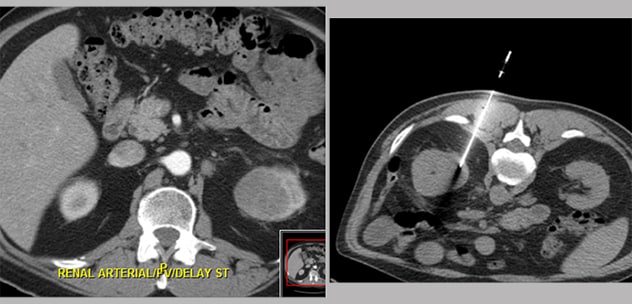Feb. 22, 2020
Upper tract urothelial carcinoma (UTUC) is a rare urologic malignancy. Unfortunately, it can also be associated with poor oncologic outcomes. The five-year cancer-specific survival is less than 50% for patients with invasive (pT2 and pT3) disease. Therefore, often radical and aggressive treatment is warranted.
"Grading and staging of UTUC is important for determining treatment strategy and for providing prognostic information for patients," says Aaron M. Potretzke, M.D., Urology, at Mayo Clinic in Rochester, Minnesota. "Current diagnostic strategies are subject to challenges and pitfalls, however. Ureteroscopic biopsy is often employed, but can be limited by the small amounts of tissue that are able to be acquired with a small, 3-French forceps. As a result, histologic yield, concordance with final pathology and staging may be inadequate."
Percutaneous biopsy
Percutaneous biopsy of solid tumors is commonplace for the diagnosis of many tumors. "In fact, percutaneous image-guided core-needle biopsy (PCNB) is favored for the biopsy of renal parenchymal lesions," says Dr. Potretzke. "There has been historical concern about tract seeding with percutaneous biopsy of UTUC. There have been rare case reports. Thus, widespread adoption of PCNB for concerning upper tract urothelial lesions has been constrained. Nevertheless, in cases where ureteroscopic biopsy is not possible, PCNB has been employed."
Outcomes of percutaneous biopsy for upper tract urothelial carcinoma
In an effort to learn more about this issue, Dr. Potretzke and a team of UTUC researchers at Mayo Clinic in Rochester, Minnesota, reviewed the institutional experience of PCNB for UTUC.
As detailed in an article published in Urology in January 2020, the research team examined the charts of 444 patients who underwent radical nephroureterectomy for UTUC between 2009 and 2017. Of those patients, 42 had undergone PCNB prior to radical nephroureterectomy.
The patients' median tumor size was 3.8 cm. There was high concordance between PCNB and final pathology (95%). While grade was provided in 69% of biopsy specimens, of those specimens with an assigned grade, there was 90% concordance with surgical pathology.
"The complications profile with this technique is promising: 14% of patients had a Clavien-Dindo grade 1 or 2 complication, and one patient had a grade 3 complication. Most importantly, there has been no evidence of tract seeding during the follow-up period (28 months)," reports Dr. Potretzke.
Individual patient factors may guide diagnostic approach
Matthew K. Tollefson, M.D., a urologic oncologist at Mayo Clinic in Rochester, Minnesota, notes the potential significance of the team's findings: "Knowing that the percutaneous biopsy approach is safe and has a high level of accuracy provides us with another tool to best provide patients with information that will inform their decision for how to treat a new diagnosis of urothelial cancer. Some patients still may be best served with ureteroscopic evaluation, but it is good to know that we can approach these tumors percutaneously and potentially derive more information from this biopsy approach."
Theodora A. Potretzke, M.D., a genitourinary radiologist at Mayo Clinic in Rochester, Minnesota, describes the radiology team's approach: "In cases of suspected upper tract urothelial carcinoma, especially when options for endoscopic tissue sampling are limited, we in Radiology are able to effectively use CT or ultrasound guidance to target a suspicious lesion. These lesions may be entirely within the collecting system or may show parenchymal invasion.
Biopsia con aguja gruesa de una lesión urotelial

Biopsia con aguja gruesa de una lesión urotelial
Biopsia percutánea con aguja gruesa guiada por tomografía computarizada de una lesión urotelial preocupante.
"The technique for percutaneous tissue sampling has an exceptional track record for safety and is very well tolerated by patients, often with use of only local anesthetic or in some cases conscious sedation. Core biopsy samples are obtained (18 gauge), which typically provide ample tissue for pathologic evaluation."
For more information
Joseph JP, et al. Percutaneous image-guided core needle biopsy for upper tract urothelial carcinoma. Urology. 2020;135:95.